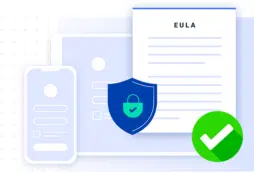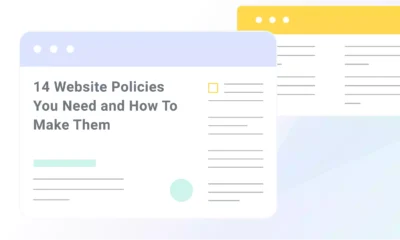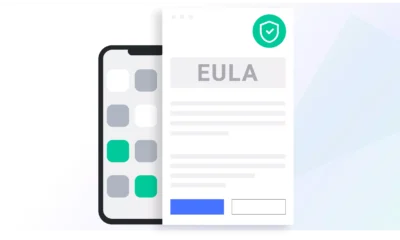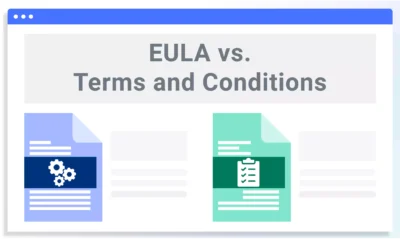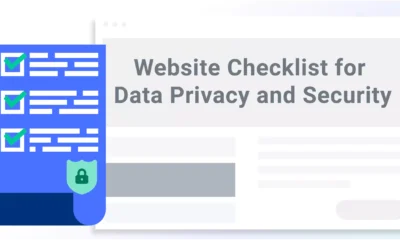An end-user license agreement (EULA) protects technology creators who make their products available for public use.
It’s typically made available alongside the software in print or digital form and often requires an end-user’s consent before they can access the product.
Download our free EULA template and read the guide below for help modifying it.
EULAs Explained
When software developers make their products available for general use, they need a way to protect their rights so that end-users can’t sell or distribute the product in a way that doesn’t benefit the creator or cause harm.
A EULA is a document that covers the intellectual property (IP) rights of the person who created the software.
Agreeing to the terms of the EULA only grants the user rights to a copy of the software. It’s also important to note that any money paid for the software by the end-user does not diminish the original owner’s rights.
Who Needs a EULA?
Any software owner who wants to protect their rights over how proprietary software gets used should have a EULA. They contain essential clauses that protect companies if someone misuses their product.
EULAs also help protect a company’s reputation. For example, a family-friendly company could include terms in a EULA that prevent users from using the business’s product with explicit adult material.
In addition, having a EULA protects your rights as the owner to revoke access to the application when users violate the terms.
Apps
If your company builds a new mobile app, a EULA helps you maintain control over the way users interact with it. For example, the it prohibits them from making unauthorized changes and selling your app as their own in the Apple or Google Play store.
Software
A EULA helps companies restrict unauthorized use of their software and protects their rights as owners. For example, you can outline that individuals can’t use your software for actions like installing malware on devices.
Consequences of Not Having a EULA
Allowing users to purchase your software without consenting to a EULA opens your business to liability. It also increases the likelihood of another user copying and redistributing your application and making a profit.
Do I Need a EULA for Different Software Versions?
Some business owners prefer to have users sign an updated EULA whenever they provide an application update. Doing so makes it clear that the changes to the product don’t invalidate the terms of the original EULA.
Are You Legally Required To Have a EULA?
While it’s not legally required, it’s good for businesses to have a EULA in place for all software products.
A EULA makes it easier for software owners to:
- Keep control of how individuals distribute and use the software
- Limit liability for potential damages
- Protect the company’s right to end a software license for improper use of the product
- Stop abuse of the software
Common EULA Clauses
Below are examples of clauses often found in our EULAs. You should think about the enforcement measures your company has in place and whether they make you capable of following through on assessing any outlined penalties because of violations.
Introduction
EULAs typically start with a section that provides:
- The name of the application
- Your company’s name
- Any other names or associates who fall under the scope of the agreement
Your EULAs intro should summarize that the document represents an agreement between the user and entities named within the contract on the use of the software.
You should also include definitions for any terms used throughout the document and the location of additional terms.
Some businesses add a notice at the end of the introduction clarifying that clicking “I accept” or “I agree” represents the user agreeing to be bound by the terms of the EULA.
Granting of Licenses
Here, your company informs users that they are allowing them to receive a license permitting them to use your application.
Be sure to add provisions that outline the scope of the license and limitations on its use. For example, you might want to add a provision stating the user can’t transfer the license to someone else.
Other standard stipulations that get written into EULAs include:
- Defining how users can access the application
- Limiting the number of downloads per license
- Stating the license can be revoked at your company’s discretion
The primary message you want the user to take away from this section is that receiving a license doesn’t grant them any ownership of the software.
You also want users to know that they can expect to encounter other limitations within the agreement as they continue reading.
Restrictions on Application Use
Most EULA contracts have detailed information in this section about restricting certain actions when using the company’s application.
The bases you should cover in your EULA include not allowing a user to:
- Send spam with the software
- Set up a profit-making scheme using your app
- Reverse-engineering the application
- Copy code from the software
- Use the application in a way that violates applicable laws
License Termination
Many EULAs have a section stating that the software owner has the right to terminate a user’s license if they’re caught violating the terms of the agreement. Additionally, the user must remove the software from any device on which they have it installed.
You can amend the clause to state that you will provide the user with a written notice a certain number of days before terminating the contract. Some companies also allow users the chance to make amends during that period before terminating the license.
Make sure your clause clearly outlines the following:
- What acts would be considered worthy of terminating the license
- How your company will execute the termination
- What the user must do after your company terminates the license
Copyright or Intellectual Property Violations
The section outlining copyright infringement lets users know that copyright laws protect your software. Make sure you detail all software, documentation, and other material that is your company’s intellectual property.
This section is another area where you make it clear to users that they have no ownership rights to your software or any trademarks your business owns.
Warranty Disclaimer
The EULA warranty clause states that you are making your company’s application available to users in its current state. Therefore, your business does not claim responsibility for covering anything beyond what is required by law.
Many companies use this section to detail any warranties offered with the software. Our EULA template can help you craft a standard disclaimer for this segment.
Your warranty clause should specify that:
- The user must make sure that the app is a good fit for their needs
- Users assume responsibility for the product after the download
- You can’t promise to keep the application free of viruses or other malicious software
The above is essential to protecting your business from legal claims issued by users who didn’t feel the product met their expectations.
Jurisdiction
It’s a good idea to include a section that clearly states which laws your business will use to defend your rights or raise a claim against a user of your software. Many companies have both the country and state listed in that section.
This clause should also clarify that your business will not abide by international laws about property rights.
Related Agreements
The related agreements sections point to other policies, like your company’s Terms and Conditions. It’s a reminder to users that they must agree to abide by other agreements before getting permission to use your business’s software.
Limits on Damage Liability
This section lets users know that you can’t be held responsible for issues that arise from their use of your company’s software. While a business can’t wholly exclude itself from all liability, you should have reasonable limitations on what your business ends up being responsible for if there is an issue with your software, including:
- A loss to the end-user’s finances or reputation
- Damages to the end-user’s system
- Personal injury to the end-user
It helps to clarify what conditions would result in liability for your business. After that, you should clearly outline the limits around that responsibility. For example, some companies put a specific dollar amount around damages users can pursue if they decide to file a claim.
Control of Software Distribution
The distribution of software clause lets users know that they can only use the app if they follow the outlined limitations. That helps your business maintain control over when and how your application gets distributed.
As a result, your company is better positioned to enforce the terms of your EULA and allow you to regulate the interactions users have with your software.
Business Contact Information
The last clause in a EULA typically provides your business’s contact information like your company’s name, address, telephone number, and email. Adding this section makes it easier for users to reach out to your business if they have any questions about the EULA.
What Makes a Good EULA?
Companies looking to write a comprehensive EULA should make it as comprehensive as possible. You can do that by sitting down and coming up with any points you want to cover.
Try to think of all issues about your intellectual rights, what users might hold you responsible for, and how you can maintain control over the use of your software.
You should also review the agreement once it’s written to prevent spelling or grammatical errors you made that might leave the EULA open to any interpretation other than what your company intended.
It’s a good idea to craft the software installation so that users can’t proceed with the download without signing off on the agreement.
Here are some additional tips to follow when setting up your EULA:
Don’t Copy Text From Another App or Software
Avoid blatantly copying the text used by other software vendors. It is their copyrighted work, meaning they could file a claim against you for co-opting their language to benefit your business.
It’s also likely that there are distinct differences between your software and another vendor that should require you to come up with the original EULA language.
Write in Clear Language and Avoid Legalese
Use precise language and avoid overloading your text with unnecessary legalese that confuse the user. Muddy or unclear contract language may also be taken advantage of by someone looking to file a legal claim against your company.
Seek Advice From an Attorney
Your EULA should have personalized language about your software and related commercial relationships. Ensure you’re using the correct language in all your company’s EULA clauses by having the document reviewed by an attorney.
They can help you spot any conflicts in the language and ensure that you’re covering all avenues for protecting your intellectual property and anticipating other issues that might arise from the use of the software.
Outline Refund Policies
Add a section that states the conditions under which a user might have the ability to request a refund. That can circumvent any desire to pursue additional legal damages if the user’s issues result from a flaw with your software.
Your business should also make it clear that there is a refund policy available so that users don’t have to do endless digging around your site to find the text.
Potential Software Resell
If your company allows it, provide details to users of the circumstances under which they can sell their software license. That cuts down on any confusion and hassle for your business and the user.
EULA Updates and Changes
Find a way to give users notice if there are any changes to the language within your EULA. Then, they should have the opportunity to decide if they accept the revisions to the contract and are willing to abide by the updated terms.
Posting Your EULA and Obtaining Consent
Your EULA should be visible to your users at several points. For example, you can include a direct link in the footer of your business website landing page. It should also appear when users click a button to download the software.
Users should also have access to the EULA within the application, in a place like Settings or the About menu.
The easiest way to obtain consent for a EULA is prohibit access to your program until a user agree to its terms.
Good Examples of EULAs
Let’s look at some examples of EULAs currently used by major software and mobile app companies.
Adobe
Adobe’s EULA makes it clear from the opening phrase that installing the software represents agreement with all limitations and restrictions. Placing it upfront allows the user to immediately decide if they want to proceed with the software download.

The following Adobe EULA section defines the terms used throughout the agreement. For example, the contract states that Adobe refers to one entity for customers who live in the US, Canada, or Mexico and another for international users.
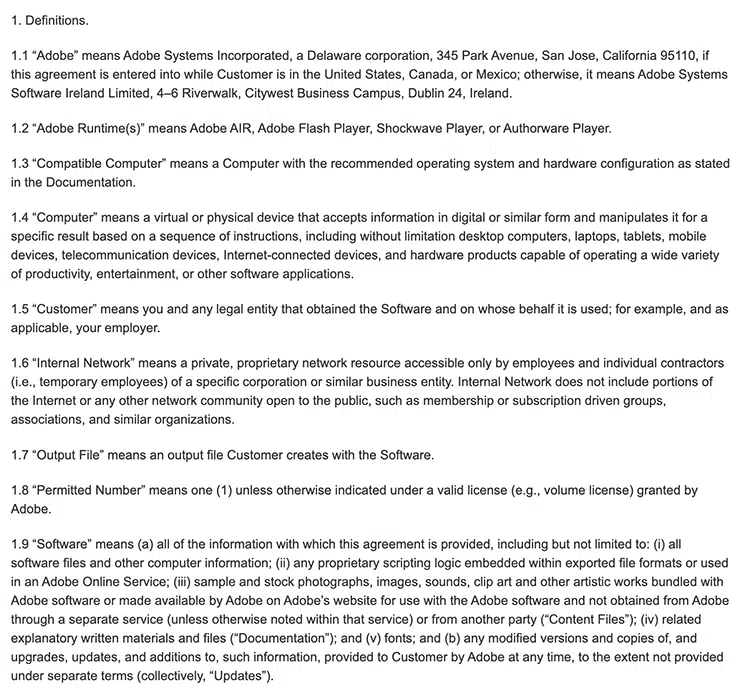
The agreement also defines what it considers a computer and actions the software might trigger if the user initiates a download.
Adobe’s EULA doesn’t use confusing legal terms and makes the text large enough to be easily read by most users. In addition, it does things like distinguishing between those who purchase a license without signing up for Adobe membership plans.
It also goes into subjects like:
- The licenses offered
- Limitations around the number of downloads
- When users are allowed to add the Adobe product to a server
Cisco
Cisco uses its EULA to cover the use of any software, whether it’s hosted on-site or in the cloud. The first section defines the scope of the agreement and how it applies to both Cisco and the user.
Cisco’s EULA is an excellent example of a contract that handles complex technical and legal topics as clearly as possible.
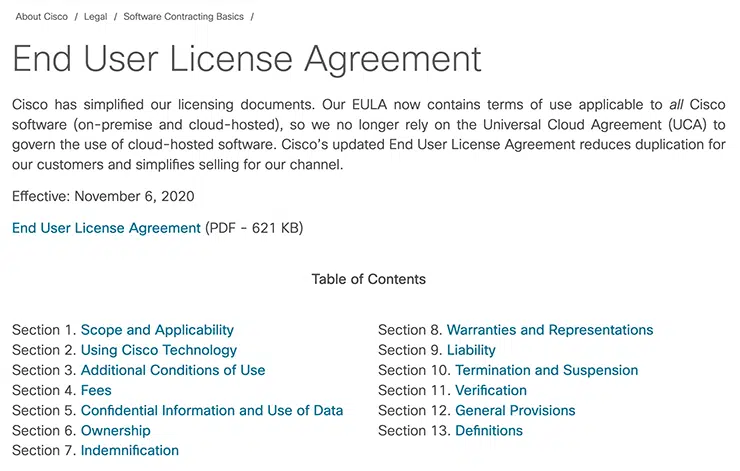
They make it clear early on that downloading, installing, or using Cisco software implies agreement with the terms of the EULA.
It also defines that any user without the authority to agree to the EULA will receive a refund within 30 days of their purchase.
Spotify
Spotify’s EULA starts with an introduction outlining the sections users should read before agreeing to the terms. It also contains a clear statement that signing up for or using the Spotify service signifies agreement with the contract terms.
Another critical section at the end of the introduction is a paragraph stating that all disputes must be handled through arbitration versus a jury trial. That helps the company limit liability over any claims brought by users over its service.
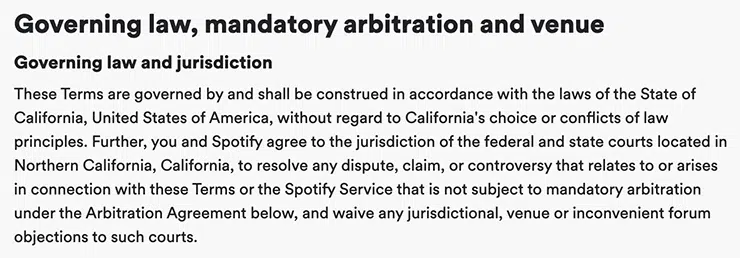
This is also a good EULA example because the company goes over every service option covered under the agreement. It also goes over how users can start using the service and defines the limited permissions granted by Spotify.
There’s also a section that covers bill payment options, the fact that the price of the service may adjust over time, and how users can terminate their use of Spotify.
Grammarly
Grammarly is a popular application used by writers to help them correct spelling and grammatical issues within their writing. Because Grammarly makes a version of its software available for free trials, their EULA clarifies early on that the contract also applies to trial users. That helps avoid the potential of users obtaining a copy of Grammarly and using it for non-intended purposes.
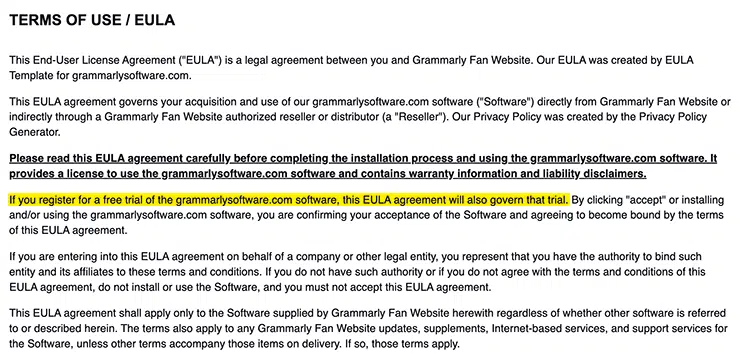
Grammarly understood that many of those using the paid version of the product would be non-technical users. Therefore, the text is easy to read, and all the clauses within the EULA are distinct, with the terms spelled out.
Some sections go over essential subjects like rights granted under a Grammarly license and when the company is allowed to terminate the use of their software.
Generic EULA Template [Sample Text and Free Download]
You can download our free EULA template below in Word Doc, PDF, or Google Doc format. You can also just copy & paste the HTML directly to your website.
Before using it, read through the entire EULA template – fill in all of the [brackets], remove any sections that do not apply to your app, and tweak any language as needed.
EULA Template HTML
You can copy our EULA template HTML code or download it using the options below.
Additional Template Download Options
Summary
A EULA should be considered essential to any company that develops and distributes software applications. Having a contract between your business and the end-user protects your rights over the software and gives your business control over its usage.
Map out the most important sections you want to include in your EULA. Our sample mobile app EULA template can help you outline the document, but you should also have the attorney review the contract before making it publicly available to users.
Be sure you get consent for your EULA and other policy documents before allowing users permission to use your application. The goal of a EULA is to protect your business from unnecessary liability and keep individuals from using your product in a way your company did not intend.



